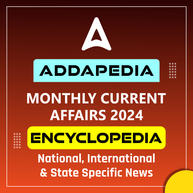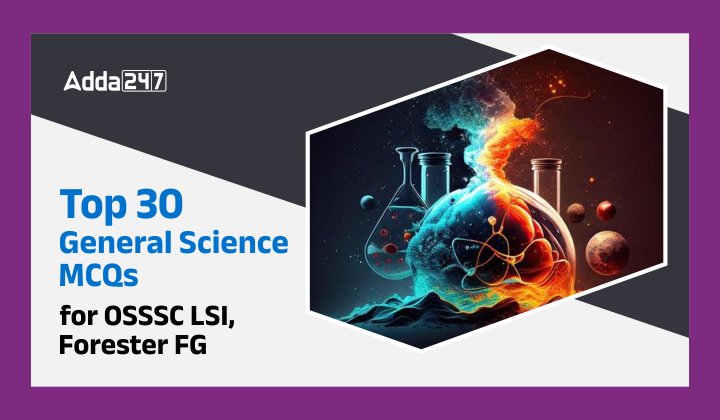General Science forms a crucial part of various competitive exams, including the OSSSC LSI (Livestock Supervisor Inspector) and Forester FG (Forest Guard) exams. Here, we present a curated list of 30 multiple-choice questions (MCQs) in General Science, covering diverse topics from physics, chemistry, biology, and environmental science. These questions are designed to test your understanding and application of scientific principles, making them suitable for candidates preparing for these examinations.
Top 30 General Science MCQs for OSSSC LSI, Forester, FG 12 March 2024
These questions provide a glimpse into the diverse range of topics covered in General Science and the types of questions you may encounter in the OSSSC LSI and Forester FG exams. To excel in these exams, candidates should focus on understanding scientific concepts, principles, and their practical applications. Continuous practice and a thorough understanding of the subject matter will undoubtedly enhance your performance in the examination.
- MethaneSAT was launched aboard which rocket?
a) SpaceX Falcon Heavy
b) SpaceX Falcon9
c) Blue Origin New Shepard
d) NASA Space Launch System (SLS)
Answer: b) SpaceX Falcon9 - What is the primary purpose of MethaneSAT?
a) Monitoring carbon dioxide levels
b) Tracking and measuring methane emissions globally
c) Observing weather patterns
d) Studying ocean currents
Answer: b) Tracking and measuring methane emissions globally - Which organization developed MethaneSAT?
a) NASA
b) Environmental Protection Agency (EPA)
c) Environmental Defense Fund (EDF)
d) European Space Agency (ESA)
Answer: c) Environmental Defense Fund (EDF) - Methane is approximately how many times more potent than carbon dioxide at warming over a 20-year period?
a) 20 times
b) 50 times
c) 80 times
d) 100 times
Answer: c) 80 times - What is the main source of human-caused methane emissions?
a) Deforestation
b) Agriculture
c) Industrial waste
d) Fossil fuel operations
Answer: d) Fossil fuel operations - MethaneSAT is equipped with which type of sensor to track methane concentrations?
a) Ultraviolet sensor
b) Infrared sensor
c) Microwave sensor
d) Radioactive sensor
Answer: b) Infrared sensor - What is the orbit frequency of MethaneSAT around the Earth?
a) 5 times a day
b) 10 times a day
c) 15 times a day
d) 20 times a day
Answer: c) 15 times a day - What size of methane concentrations can MethaneSAT detect?
a) 30 parts per billion
b) 10 parts per billion
c) 5 parts per billion
d) 3 parts per billion
Answer: d) 3 parts per billion - MethaneSAT’s wide-camera view allows it to identify larger emitters known as what?
a) Mega emitters
b) Super emitters
c) Ultra emitters
d) Giant emitters
Answer: b) Super emitters - Besides methane emissions, what other pollutant does MethaneSAT monitor?
a) Nitrogen oxide
b) Sulfur dioxide
c) Ground-level ozone
d) Carbon monoxide
Answer: c) Ground-level ozone - Which institution signed a Memorandum of Understanding (MoU) with the Government Medical College of Vizianagaram?
a) Government Medical College of Vizianagaram
b) Centurion University of Technology and Management (CUTM), Vizianagaram
c) Vizianagaram University
d) Government Medical College of Andhra Pradesh
Answer: b) Centurion University of Technology and Management (CUTM), Vizianagaram - What is the purpose of the MoU between CUTM and the Government Medical College of Vizianagaram?
a) To provide scholarships to medical students
b) To conduct joint research projects
c) To offer practical training opportunities for CUTM students
d) To establish a new medical college
Answer: c) To provide practical training opportunities for CUTM students - Who initiated the construction of ISRO’s second rocket launchport?
a) President Ram Nath Kovind
b) Prime Minister Narendra Modi
c) ISRO Chairman K. Sivan
d) Tamil Nadu Chief Minister M.K. Stalin
Answer: b) Prime Minister Narendra Modi - Why does India need a new launchport, according to the context?
a) To decrease commercial launches
b) To increase pressure on existing facilities
c) To avoid overloading ISRO’s Satish Dhawan Space Centre (SDSC) SHAR
d) To focus only on larger missions like lunar, Venus, and human-flight missions
Answer: c) To avoid overloading ISRO’s Satish Dhawan Space Centre (SDSC) SHAR - What kind of payloads will the Kulasekarapattinam launchport handle?
a) Only larger payloads
b) Only human-flight missions
c) Only smaller payloads
d) Both larger and smaller payloads
Answer: c) Only smaller payloads - How does the Kulasekarapattinam launchport benefit the SSLV missions?
a) It allows an eastward trajectory
b) It offers a direct northward trajectory
c) It provides a direct southward trajectory
d) It facilitates a westward trajectory
Answer: c) It provides a direct southward trajectory - Why is the geographical location of Kulasekarapattinam advantageous?
a) It is located in Maharashtra
b) It is centrally located in India
c) It is located in Tamil Nadu and offers a coastal advantage
d) It is located near the Himalayan region
Answer: c) It is located in Tamil Nadu and offers a coastal advantage - What benefit does Kulasekarapattinam’s westward location offer for SSLV missions?
a) It saves fuel compared to the eastward trajectory required from SHAR
b) It increases fuel consumption compared to the eastward trajectory required from SHAR
c) It has no impact on fuel consumption for SSLV missions
d) It allows for a direct northward trajectory
Answer: a) It saves fuel compared to the eastward trajectory required from SHAR - How does the proximity to the equator benefit both launchports?
a) It decreases payload capacity
b) It decreases velocity due to Earth’s rotation
c) It has no impact on payload capacity
d) It increases payload capacity due to Earth’s rotational velocity
Answer: d) It increases payload capacity due to Earth’s rotational velocity - What is the primary purpose of the Kulasekarapattinam launchport?
a) To focus on larger missions like lunar, Venus, and human-flight missions
b) To handle only SSLV missions
c) To facilitate on-demand commercial launches
d) To relieve pressure on SHAR and handle smaller payloads
Answer: d) To relieve pressure on SHAR and handle smaller payloads - What is Iris AI Robot’s primary function in education?
a) Performing administrative tasks in schools
b) Assisting teachers in grading assignments
c) Acting as an interactive learning tool and AI teacher
d) Providing physical education training
Answer: c) Acting as an interactive learning tool and AI teacher - What technology powers Iris AI Robot?
a) Artificial Neural Networks
b) Robotics and Generative AI
c) Quantum Computing
d) Augmented Reality
Answer: b) Robotics and Generative AI - What feature of Iris allows users to control and interact with it?
a) Dedicated Intel processor
b) Android App interface
c) Hands with 5 DoF each
d) 4-wheel chassis
Answer: b) Android App interface - In how many languages does Iris currently speak?
a) One
b) Two
c) Three
d) Four
Answer: c) Three - Which company created Iris AI Robot?
a) Intel Corporation
b) Google LLC
c) Microsoft Corporation
d) Maker Labs
Answer: d) Maker Labs - What type of learning experiences does Iris engage users in?
a) Passive observation
b) Memorization-based tasks
c) Interactive learning experiences
d) Physical activities
Answer: c) Interactive learning experiences - What is the mobility feature of Iris AI Robot?
a) 5 DoF hands
b) Dedicated Intel processor
c) 4-wheel chassis
d) Android App interface
Answer: c) 4-wheel chassis - What educational levels can Iris teach?
a) Nursery to Class 5
b) Class 6 to Class 10
c) Nursery to Class 12
d) College and University levels
Answer: c) Nursery to Class 12 - How does Iris assist users in learning activities?
a) By remaining passive in the classroom
b) By providing demonstrations and manipulations with its hands
c) By controlling the classroom environment
d) By grading assignments
Answer: b) By providing demonstrations and manipulations with its hands - What distinguishes Iris AI Robot from traditional teaching methods?
a) Lack of personalization in learning experiences
b) Limited mobility and interaction capabilities
c) Integration of AI technology for personalized learning and interaction
d) Strict adherence to standardized curriculum
Answer: c) Integration of AI technology for personalized learning and interaction










